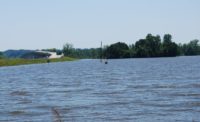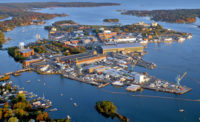The proposed $1.4 billion project to rebuild Louisiana’s coastal wetlands reached a critical milestone in its permitting process March 5, when the U.S. Army Corps of Engineers released its draft report detailing the project’s environmental impact. The consensus among state officials and experts is that the benefits are well worth the risk.
The Corps’ draft environmental impact statement is the culmination of four years of data collection on the project, the Mid-Barataria Sediment Diversion. The project is a cornerstone of the state’s ambitious 50-year, $50 billion coastal master plan, and draft’s completion brings the state one step closer to constructing one of the largest environmental infrastructure projects in the nation’s history.
“As a concept, it’s a game changer,” says Kristi Trail, professional engineer and executive director of the Pontchartrain Conservancy, a nonprofit that advocates for environmental sustainability through scientific research. “We see it as something that must move forward in order to change how things are going with our current land loss.”
The project involves creating a large-scale river diversion system that would redirect sediment, fresh water and nutrients from the Mississippi River into the Barataria Basin to rebuild the wetlands over time. In the report, the Corps determined that the project would rebuild wetlands and restore habitats and ecosystems that were harmed by the Deepwater Horizon oil spill in 2010. An $8 billion settlement from BP is covering the entire cost of the sediment diversion project.
A major benefit of the project, according to the report, is that it would add 27 sq miles (17,300 sq ft) of land to the eroding Barataria Basin by 2050. However, that number would dwindle to 21 miles by 2070 because of ongoing land loss. Another benefit is that constructing the sediment diversion could reduce storm surge by up to 1 ft during a 100-year storm. This would provide additional protection to West Bank communities with low-income and minority populations.
“This is a prime example of how to build back better in a way that builds lasting climate resilience for our vulnerable communities,” Trail says.
But a key concern about the project is that it would reduce the populations of oysters, brown shrimp and finfish in the Barataria Basin, and these impacts could affect commercial and recreational fishing. According to the Corps report, the project’s operation “is expected to have both beneficial and adverse direct and indirect impacts on fish abundance in the project area,” as certain species may become more abundant, while others will diminish.
“For us, a future without the diversion would cause extreme land loss and further saltwater intrusion, and that will have a bigger impact on the community and the industry as a whole,” Trail says.
The Corps report is meant to provide an objective, extensive review of the environmental benefits and detriments of the project. It also looks at what the impacts to the basin would be if the project is not built.
“At the end of the day, our decision will be based on science and engineering, but we also have to determine if this is in a project that’s in the best interests of the nation,” says Ricky Boyett, spokesman for the U.S. Army Corps of Engineers New Orleans District.
State officials suggest the signs point to yes.
“The science is clear: This project is our best opportunity to create a sustainable Barataria Basin for our children and grandchildren,” said Coastal Protection and Restoration Authority of Louisiana Executive Director Bren Haase in a prepared statement the authority issued after the release of the draft report.
The project, which would take five years to construct, involves building a two-mile, concrete diversion structure in lower Plaquemines Parish that would carry up to 75,000 cu ft per second of fresh water, sediment and nutrients from the Mississippi River to the mid-Barataria Basin in Plaquemines and Jefferson parishes.
“As far as we can tell, this is the single-largest ecosystem restoration project in the United States. It’s going to build more wetlands than any other restoration project in the world, which for us is what we need to solve the challenges we face,” Trail says.
Now that the draft report is complete, there will be a 60-day public comment period through May 4 to determine whether there are any other environmental impacts the Corps should address in its final statement. The final version is scheduled to come out in March 2022. The permitting process would be complete in April 2022.





Post a comment to this article
Report Abusive Comment